oatmeal bread
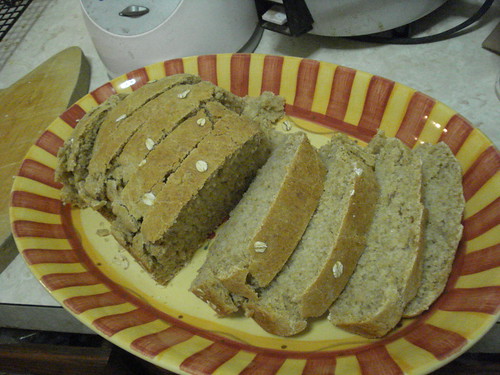 Saturday was a nasty day in New York: cold, gloomy and rainy, with snow making a halfhearted attempt to fall closer to sundown. Scott was fighting off a cold. It seemed like a perfect day to make soup, but I didn’t feel like digging out a soup recipe from the blog cookbooks; I wanted to make my usual improvised chicken soup. Still, it seemed to be high time to knock off another
Saturday was a nasty day in New York: cold, gloomy and rainy, with snow making a halfhearted attempt to fall closer to sundown. Scott was fighting off a cold. It seemed like a perfect day to make soup, but I didn’t feel like digging out a soup recipe from the blog cookbooks; I wanted to make my usual improvised chicken soup. Still, it seemed to be high time to knock off another 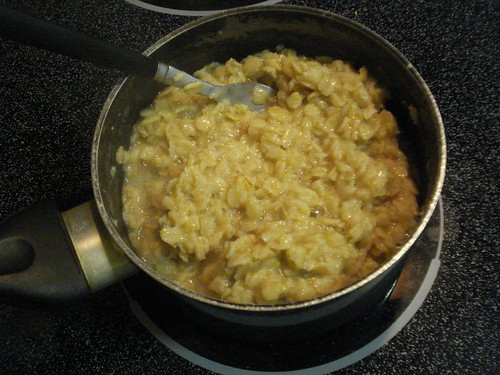 blog post, so I looked at my current stack. Bread! This would also be a great day to make bread.
blog post, so I looked at my current stack. Bread! This would also be a great day to make bread.
The Laurel’s Kitchen Bread Book is a compendium of bread recipes from Laurel Robertson, author of the popular Laurel’s Kitchen vegetarian cookbooks. The book was a gift from a friend, and I realized a few things as I was 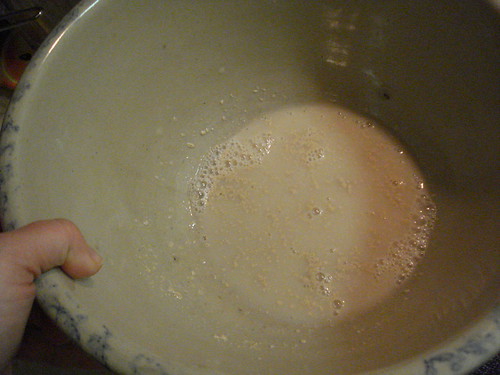 flipping through it, the chief thing being that I should have started working on the bread a lot earlier in the day. For oatmeal bread I’d need to cook up some oatmeal and let it cool, though I didn’t have the “several hours” recommended in the recipe. Would something else be faster? Anything with “overnight started” was probably out. I flipped through the pages. “For a 12-hour
flipping through it, the chief thing being that I should have started working on the bread a lot earlier in the day. For oatmeal bread I’d need to cook up some oatmeal and let it cool, though I didn’t have the “several hours” recommended in the recipe. Would something else be faster? Anything with “overnight started” was probably out. I flipped through the pages. “For a 12-hour  rise…” was the quicker version for one bread. It looked like oatmeal was my best bet, but I would need to get cracking.
rise…” was the quicker version for one bread. It looked like oatmeal was my best bet, but I would need to get cracking.
As I cooked the oatmeal I thought about how similar this recipe was to another favorite oatmeal loaf, from The Enchanted Broccoli Forest, another vegetarian classic. In both, you cook and cool the oatmeal, then mix in salt,  sweetener (usually but not necessarily honey) and oil, and add it to the proofed yeast and flour. The Enchanted Broccoli Forest doesn’t require quite as many rises, though, and my focus on quantity rather than process — along with my consciousness of the ticking clock — ultimately led me into error.
sweetener (usually but not necessarily honey) and oil, and add it to the proofed yeast and flour. The Enchanted Broccoli Forest doesn’t require quite as many rises, though, and my focus on quantity rather than process — along with my consciousness of the ticking clock — ultimately led me into error.
I cooked and cooled oatmeal. 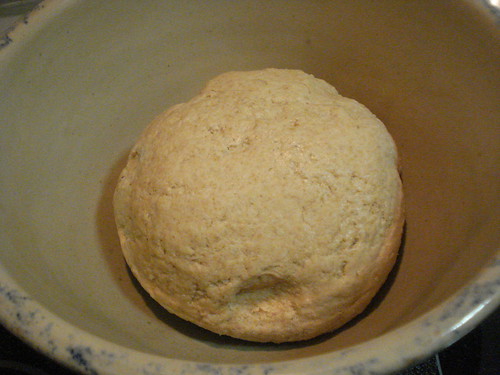 When the oatmeal had cooled enough, I dissolved some yeast in warm water. (May I put in a plug here for bulk packages of yeast? So much better quality, and less expensive per use, than the little sheaf of three servings.) I stirred some honey and vegetable oil into the oatmeal (I had already salted it right after I took it off the burner), then mixed it into the yeast mixture and added five
When the oatmeal had cooled enough, I dissolved some yeast in warm water. (May I put in a plug here for bulk packages of yeast? So much better quality, and less expensive per use, than the little sheaf of three servings.) I stirred some honey and vegetable oil into the oatmeal (I had already salted it right after I took it off the burner), then mixed it into the yeast mixture and added five  cups of flour. Laurel recommends five cups of finely ground whole wheat flour; I wasn’t sure exactly what she meant so I ended up using two cups of whole wheat pastry flour, two cups of whole wheat flour, and one cup of white flour. The mixture started out thick and stiff, but as I kneaded it, the moisture gradually worked out of the oatmeal into the rest of the dough and the mass became
cups of flour. Laurel recommends five cups of finely ground whole wheat flour; I wasn’t sure exactly what she meant so I ended up using two cups of whole wheat pastry flour, two cups of whole wheat flour, and one cup of white flour. The mixture started out thick and stiff, but as I kneaded it, the moisture gradually worked out of the oatmeal into the rest of the dough and the mass became 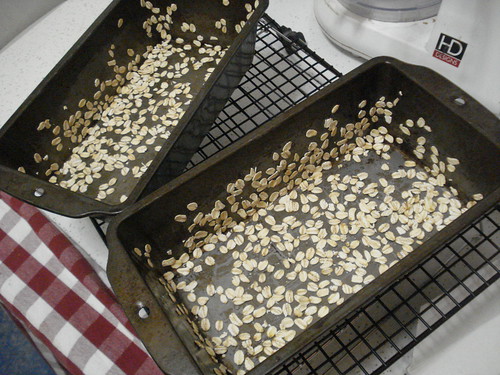 soft and pliable. When it felt right to me, after about 10 minutes of kneading, I washed and oiled the original bowl, shaped the dough into a ball, and set it to rise, covered, for not quite an hour and a half.
soft and pliable. When it felt right to me, after about 10 minutes of kneading, I washed and oiled the original bowl, shaped the dough into a ball, and set it to rise, covered, for not quite an hour and a half.
When the kitchen timer went off I came out to inspect the dough. It looked larger, but the cookbook recommends you test the texture 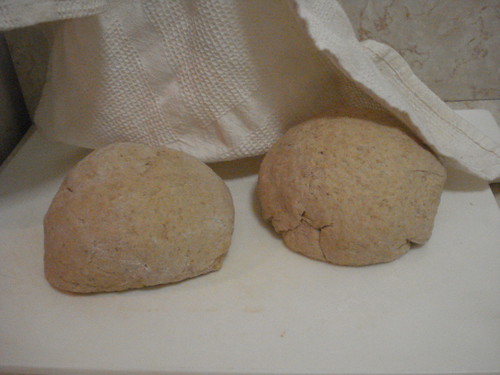 rather than relying on volume. So I poked a finger in about half an inch, and the hole did not close up; this meant it was ready to press into a somewhat flat disc and allow to rise for about 40 minutes. During this rise I cut up my soup vegetables. When the timer went off, I followed Laurel’s instructions and shaped the dough into two balls, which I then let rest. “Until they are much
rather than relying on volume. So I poked a finger in about half an inch, and the hole did not close up; this meant it was ready to press into a somewhat flat disc and allow to rise for about 40 minutes. During this rise I cut up my soup vegetables. When the timer went off, I followed Laurel’s instructions and shaped the dough into two balls, which I then let rest. “Until they are much  softer” was the direction, but they seemed quite soft to me; I let them sit for 10 minutes, during which time I set the oven to preheat, then greased two loaf pans and sprinkled them with rolled oats. I shaped the dough balls into loaves and laid them in the pans.
softer” was the direction, but they seemed quite soft to me; I let them sit for 10 minutes, during which time I set the oven to preheat, then greased two loaf pans and sprinkled them with rolled oats. I shaped the dough balls into loaves and laid them in the pans.
This is where I messed up. I misread the recipe, and I was 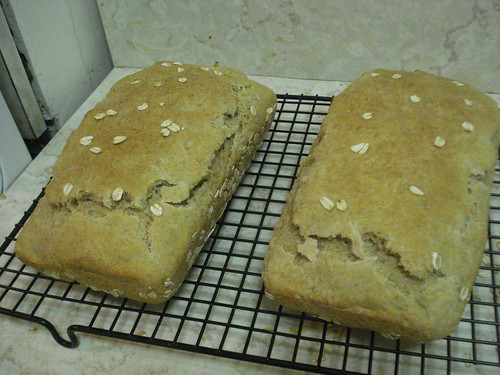 thinking, “two rises, that’s pretty standard.” So I failed to catch that I was supposed to let the dough rise once again in the pans, “until doubled.” In my defense, it was getting rather late already. I suppose that’s no defense. I should have cooked the oatmeal earlier in the day, which means I should have decided earlier in the day to make soup and bread, which means I should
thinking, “two rises, that’s pretty standard.” So I failed to catch that I was supposed to let the dough rise once again in the pans, “until doubled.” In my defense, it was getting rather late already. I suppose that’s no defense. I should have cooked the oatmeal earlier in the day, which means I should have decided earlier in the day to make soup and bread, which means I should  have gotten out of bed earlier. Oops. Instead, I blithely slid the pans into the preheated oven, and set about making soup.
have gotten out of bed earlier. Oops. Instead, I blithely slid the pans into the preheated oven, and set about making soup.
I didn’t realize my mistake until about 5 minutes before the bread was due to come out of the oven, which was rather too late to do anything about it. The loaves did puff up a bit while baking, but clearly they are flatter than they would have been if given their last rise. They were also a bit denser than the recipe described, which is not surprising. The taste was good, though I think it would have been a little bit richer and mellower if I had followed instructions. No matter. The bread was still a fine accompaniment to soup.
Verdict: Success, but points off for technical error. I’ll have to try the recipe again some time, starting it earlier in the day.